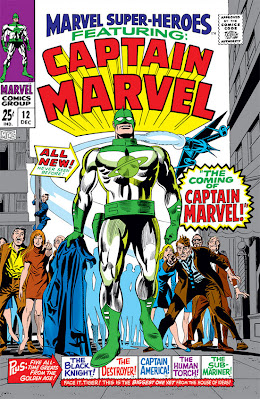 If you haven't yet read the story of the Avengers' first battle with Graviton, which took place in Avengers #s 158-159, you may be expecting a lot more than what you'll actually find. Obviously, this is just one guy vs. the assembled Avengers, so your first impression might be that there has to be a lot more to him than just a flashy costume. And being called "Graviton," it's a fair bet that he controls gravity in some way. Ergo, his gravity power is impressive enough to merit a full complement of Avengers taking him on. Lots of solo villains have taken on the Avengers before, after all--so there's no reason to think that Graviton wouldn't be able to hold his own, at least for a little while.
If you haven't yet read the story of the Avengers' first battle with Graviton, which took place in Avengers #s 158-159, you may be expecting a lot more than what you'll actually find. Obviously, this is just one guy vs. the assembled Avengers, so your first impression might be that there has to be a lot more to him than just a flashy costume. And being called "Graviton," it's a fair bet that he controls gravity in some way. Ergo, his gravity power is impressive enough to merit a full complement of Avengers taking him on. Lots of solo villains have taken on the Avengers before, after all--so there's no reason to think that Graviton wouldn't be able to hold his own, at least for a little while.On the other hand, this is Graviton's first time out of the gate. He's experimented with his power up to this point, but he's never used it tactically, and he's certainly had no practice in battling an elite, trained group of super-beings all at once. Few novices in their right mind would want to cut their teeth taking on the Avengers. So how much of a threat can this guy really be?
That's probably a question the Avengers were asking themselves as they gathered to confront him on his newly-risen sky island, in response to an emergency call for help. The team had only recently pulled its ranks together, following a vicious fight between the Vision and Wonder Man. And they've only had the most minimal briefing on Frank Hall, whose work on a teleport beam coincided with the energized atoms of a radioactive anti-gravity element to infuse him with the power to control gravity. "Graviton" might be what a refit of the Wizard would look like, had that villain's power over gravity been put to more aggressive use in his schemes.
But with their internal conflicts put on hold, the Avengers certainly look like they're ready to take this guy down, whatever his threat level. And, really, what can a fresh-out-of-the-box villain do if a team of Avengers, at peak strength, descends on him?
Well, new reader, get ready to have your jaw hit the floor like the rest of us who read this story the first time around, because Graviton apparently did pretty well his first time out:

















































